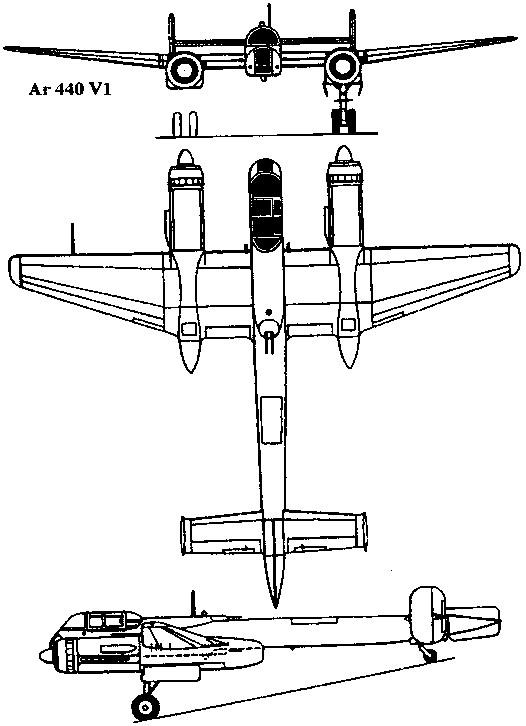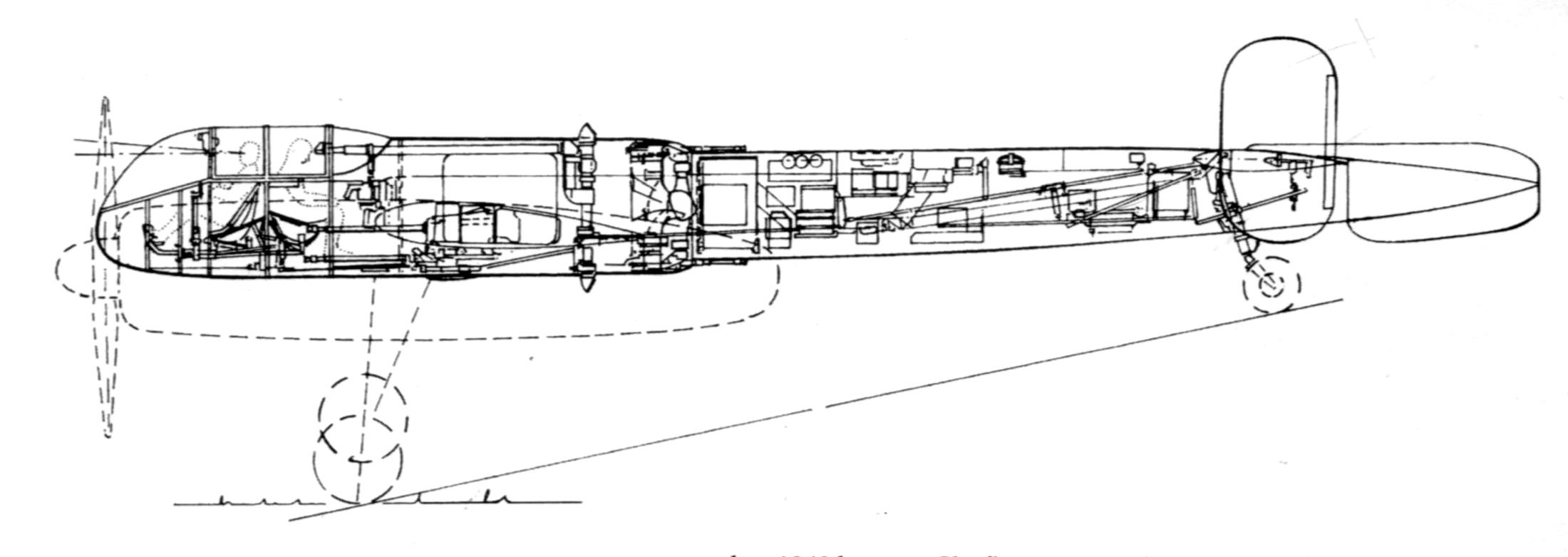| Type | A-0 2-seat heavy fighter |
| Engine | 2 Daimler-Benz DB 603G |
| Dimensions | Length 14,30 m , height 4,00 m , span 16,30 m , wing area 34,0 m2 , |
| Weights | Empty 9200 kg, loaded 12210 kg , max. take off weight |
| Performance | Max.. speed 747 km/h , cruising speed 696 km/h , range 2700 km, endurance , service ceiling , climb |
| Armament | 2 30-mm MK-108 cannons and two 20-mm MG-151 cannons forward and two 13-mm MG-131 machine guns in the upper and lower remote-controlled mounts, one fixed 20-mm MG-151 cannon in the rear; up to 1000kg of bombs |
| Type | Werk.Nr | Registration | History |
| Modified Ar 240 , DB 603A ??? | |||
| Modified Ar 240 DB 603G ??? |
The unsatisfactory flight characteristics of the Ar.240 were taken into account by Arado, and in early 1942, a substantially modified machine appeared on its basis. She received the designation Ar.440. According to the test pilots, there was no trace of the previous shortcomings. By the end of November, four prototypes were built, which were transferred to the test unit for development flights. One of the experienced pilots who thoroughly studied the Ar.440A was Lieutenant Werner Tierfelder. In his final report, he gave the aircraft only positive ratings and described it as an excellent fighter-bomber. Since this class was introduced to the Luftwaffe by the Me-410 and Ju-88 aircraft, the Technical Directorate did not dare to issue a serial order to the company, although Arado could immediately begin production of a new machine using the old Ar-240 equipment.
Ar.440 was equipped with two DB-603G high-altitude engines with GM1 device. The engine rotated a four-blade VDM variable-pitch propeller with a diameter of 3.40 m. The armament of the Ar.440, like that of the Ar-240, consisted of a fixed offensive and a mobile defensive one. Two 30-mm MK 108 cannons with 200 rounds of ammunition were installed at the wing root, and two 20-mm MG 151 cannons with 600 rounds of ammunition were located in the front lower part of the fuselage. The MK 108 guns, if necessary, could be replaced by a 30-mm MK 103. Two turrets guided by periscopes each contained two MG131 machine guns with 900 rounds of ammunition. In addition to all this, a ventral container with two MG 151/20 guns could be mounted, and one MG151 could be installed in the tail sections of the engine nacelles. A suspension of a large-caliber gun was envisaged in the so-called "Giscan" under the fuselage. In the modification of the fighter-bomber, two ETC 500 holders were installed under the middle part of the fuselage with a maximum load of 1800 kg. In addition, aerial cameras could be placed in the engine nacelles.
With a takeoff weight of about 12 tons, Ar.440 reached a maximum speed of almost 700 km / h, and when the GM1 device was turned on, it increased to 750 km / h. The normal fuel supply was 1347kg. It was located in the fuselage (533 kg) and four wing tanks (two 213 and two 194 kg each). Soft insert tanks were protected. For long-distance flights, two drop tanks of 450 kg each were suspended under the consoles. In this case, the Ar.440 range reached 2700 km. The radio equipment included a radio compass, a shortwave radio station, a radio altimeter and a friend or foe transponder. During the formation of an emergency fighter program in the summer of 1944, along with other samples, the Ar.440 was also proposed. But with the final choice, the Technical Department abandoned this type in favor of the Do-335, whose characteristics not only surpassed all known piston aircraft, but also reached the performance of new jet machines. And if we take the Do-335 as a starting point, then the Ar.440 was the second fastest Luftwaffe piston aircraft created during the war.
Ar.440 was equipped with two DB-603G high-altitude engines with GM1 device. The engine rotated a four-blade VDM variable-pitch propeller with a diameter of 3.40 m. The armament of the Ar.440, like that of the Ar-240, consisted of a fixed offensive and a mobile defensive one. Two 30-mm MK 108 cannons with 200 rounds of ammunition were installed at the wing root, and two 20-mm MG 151 cannons with 600 rounds of ammunition were located in the front lower part of the fuselage. The MK 108 guns, if necessary, could be replaced by a 30-mm MK 103. Two turrets guided by periscopes each contained two MG131 machine guns with 900 rounds of ammunition. In addition to all this, a ventral container with two MG 151/20 guns could be mounted, and one MG151 could be installed in the tail sections of the engine nacelles. A suspension of a large-caliber gun was envisaged in the so-called "Giscan" under the fuselage. In the modification of the fighter-bomber, two ETC 500 holders were installed under the middle part of the fuselage with a maximum load of 1800 kg. In addition, aerial cameras could be placed in the engine nacelles.
With a takeoff weight of about 12 tons, Ar.440 reached a maximum speed of almost 700 km / h, and when the GM1 device was turned on, it increased to 750 km / h. The normal fuel supply was 1347kg. It was located in the fuselage (533 kg) and four wing tanks (two 213 and two 194 kg each). Soft insert tanks were protected. For long-distance flights, two drop tanks of 450 kg each were suspended under the consoles. In this case, the Ar.440 range reached 2700 km. The radio equipment included a radio compass, a shortwave radio station, a radio altimeter and a friend or foe transponder. During the formation of an emergency fighter program in the summer of 1944, along with other samples, the Ar.440 was also proposed. But with the final choice, the Technical Department abandoned this type in favor of the Do-335, whose characteristics not only surpassed all known piston aircraft, but also reached the performance of new jet machines. And if we take the Do-335 as a starting point, then the Ar.440 was the second fastest Luftwaffe piston aircraft created during the war.









